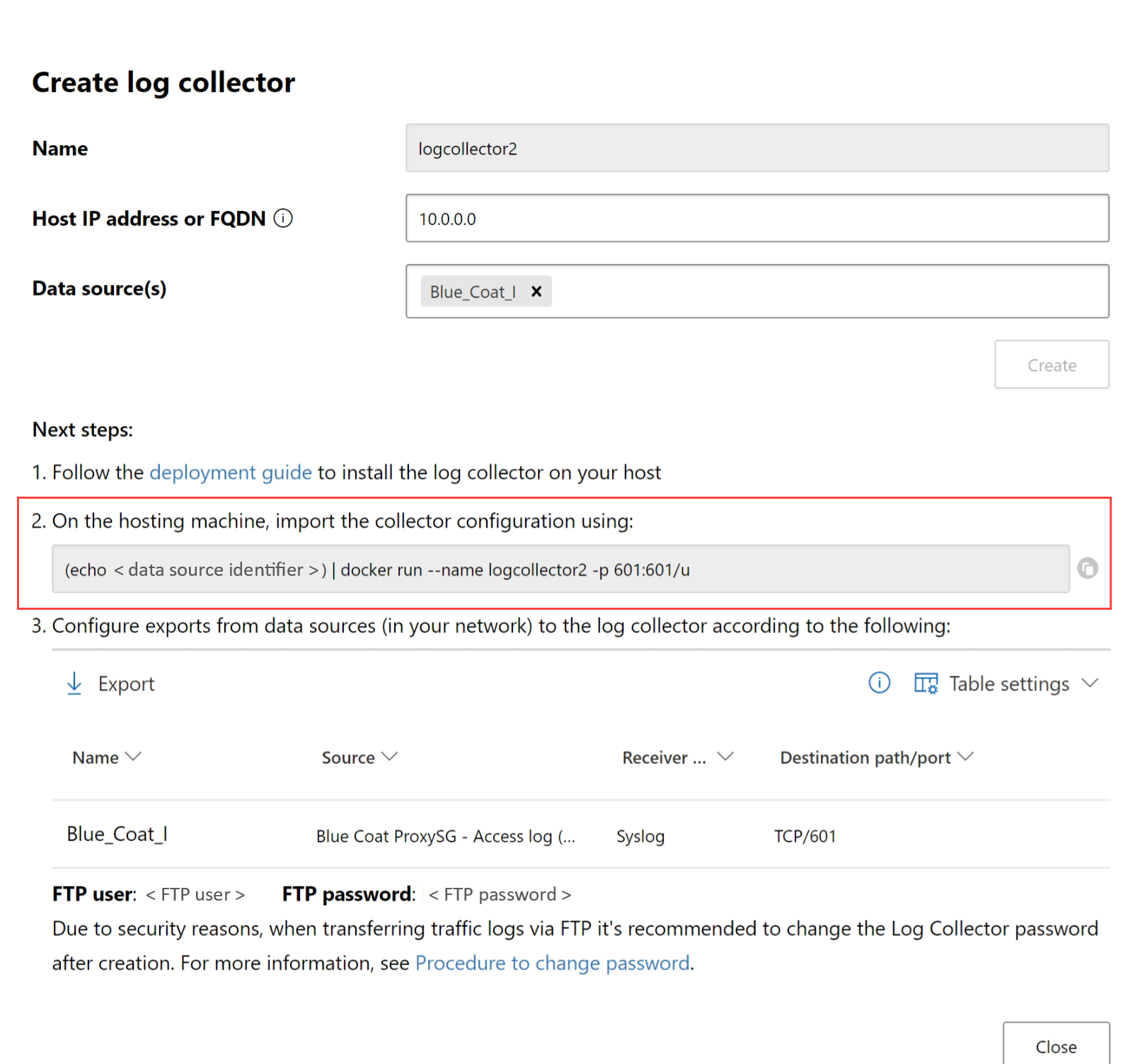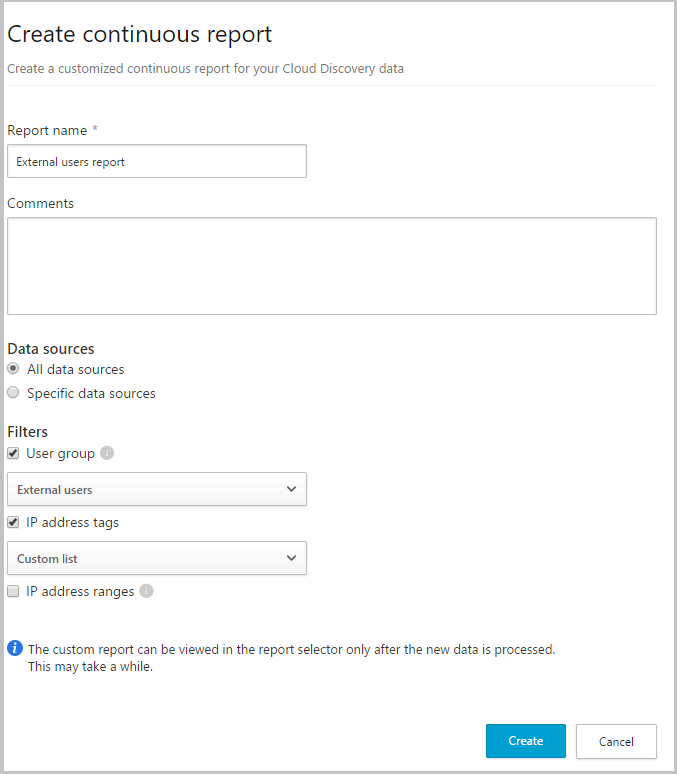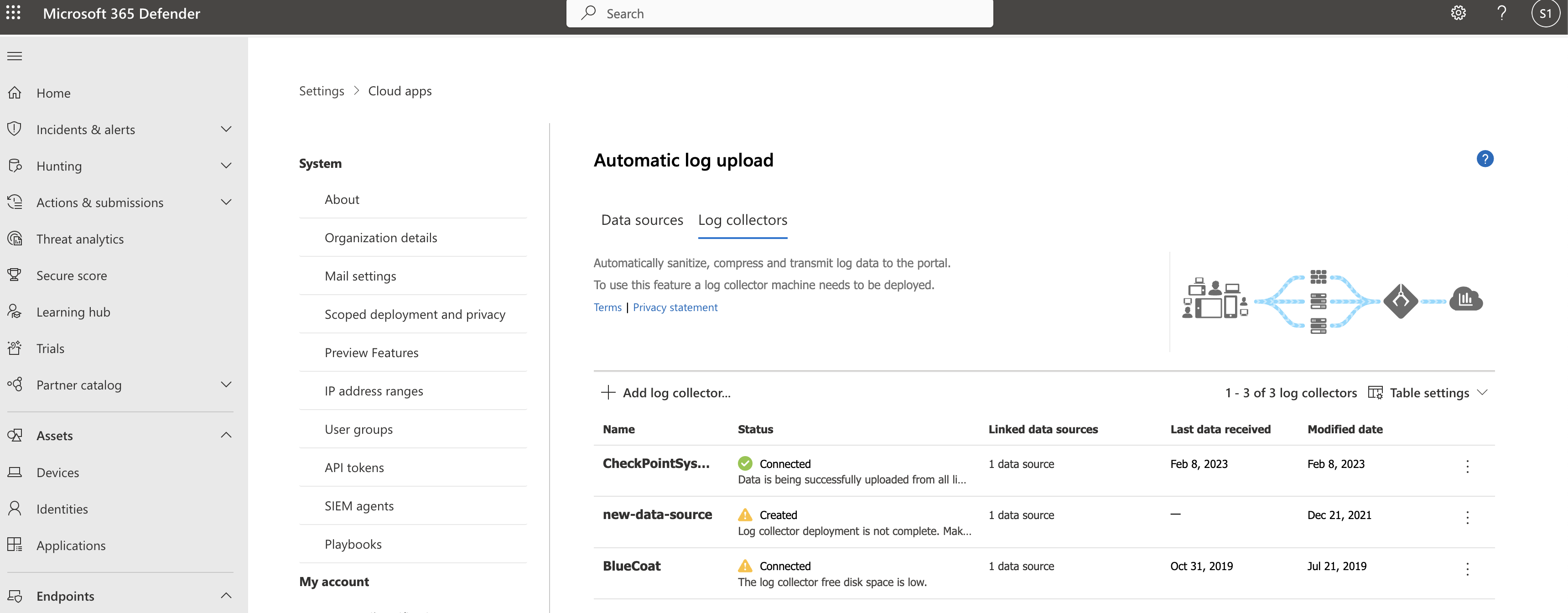Configure automatic log upload using Docker in Azure
This article describes how to configure automatic log uploads for continuous reports in Defender for Cloud Apps using a Docker on Ubuntu or CentOS in Azure.
Prerequisites
Before you start, make sure that your environment meets the following requirements:
| Requirement | Description |
|---|---|
| OS | One of the following: - Ubuntu 14.04, 16.04, 18.04, and 20.04 - CentOS 7.2 or higher |
| Disk space | 250 GB |
| CPU cores | 2 |
| CPU architecture | Intel 64 and AMD 64 |
| RAM | 4 GB |
| Firewall configuration | As defined in Network requirements |
Plan your log collectors by performance
Each log collector can successfully handle log capacity of up to 50 GB per hour comprised of up to 10 data sources. The main bottlenecks in the log collection process are:
Network bandwidth - Your network bandwidth determines the log upload speed.
I/O performance of the virtual machine - Determines the speed at which logs are written to the log collector's disk. The log collector has a built-in safety mechanism that monitors the rate at which logs arrive and compares it to the upload rate. In cases of congestion, the log collector starts to drop log files. If your setup typically exceeds 50 GB per hour, we recommend that you split the traffic between multiple log collectors.
If you require more than 10 data sources, we recommend that you split the data sources between multiple log collectors.
Define your data sources
In the Microsoft Defender Portal, select Settings > Cloud Apps > Cloud Discovery > Automatic log upload.
On the Data sources tab, create a matching data source for each firewall or proxy from which you want to upload logs:
Select Add data source.
In the Add data source dialog, enter a name for your data source, and then select the source and receiver type.
Before selecting a source, select View sample of expected log file and compare your log with the expected format. If your log file format doesn't match this sample, add your data source as Other.
To work with a network appliance that isn't listed, select Other > Customer log format or Other (manual only). For more information, see Working with the custom log parser.
Note
Integrating with secure transfer protocols (FTPS and Syslog – TLS) often requires additional settings on your firewall/proxy. For more information, see Advanced log collector management.
Repeat this process for each firewall and proxy whose logs can be used to detect traffic on your network.
We recommend that you set up a dedicated data source per network device, enabling you to monitor the status of each device separately for investigation purposes, and to explore Shadow IT Discovery per device if each device is used by a different user segment.
Create a log collector
In the Microsoft Defender Portal, select Settings > Cloud Apps > Cloud Discovery > Automatic log upload.
On the Log collectors tab, select Add log collector.
In the Create log collector dialog, enter the following details:
- A name for your log collector
- The host IP address, which is the private IP address of the machine you'll use to deploy the Docker. The host IP address can also be replaced with the machine name, if there is a DNS server or equivalent to resolve the host name.
Then select the Data source(s) box to select the data sources you want to connect to the collector, and select Update to save your changes. Each log collector can handle multiple data sources.
The Create log collector dialog shows further deployment details, including a command to import the collector configuration. For example:

Select the
 Copy icon next to the command to copy it to your clipboard.
Copy icon next to the command to copy it to your clipboard.The details displayed in the Create log collector dialog differ, depending on the selected source and receiver types. For example, if you selected Syslog, the dialog includes details about which port the syslog listener is listening on.
Copy the contents of the screen and save them locally, as you'll need them when you configure the log collector to communicate with Defender for Cloud Apps.
Select Export to export the source configuration to a .CSV file that describes how to configure the log export in your appliances.
Tip
For users sending log data via FTP for the first time, we recommend changing the password for the FTP user. For more information, see Changing the FTP password.
Deploy your machine in Azure
This procedure describes how to deploy your machine with Ubuntu. The deployment steps for other platforms are slightly different.
Create a new Ubuntu machine in your Azure environment.
After the machine is up, open the ports:
In the machine view, go to Networking select the relevant interface by double-clicking on it.
Go to Network security group and select the relevant network security group.
Go to Inbound security rules and click Add.
Add the following rules (in Advanced mode):
Name Destination port ranges Protocol Source Destination caslogcollector_ftp 21 TCP Your appliance's IP address's subnetAny caslogcollector_ftp_passive 20000-20099 TCP Your appliance's IP address's subnetAny caslogcollector_syslogs_tcp 601-700 TCP Your appliance's IP address's subnetAny caslogcollector_syslogs_udp 514-600 UDP Your appliance's IP address's subnetAny
For more information, see Work with security rules.
Go back to the machine and click Connect to open a terminal on the machine.
Change to root privileges using
sudo -i.If you accept the software license terms, uninstall old versions and install Docker CE by running the commands appropriate for your environment:
Remove old versions of Docker:
yum erase docker docker-engine docker.ioInstall Docker engine prerequisites:
yum install -y yum-utilsAdd Docker repository:
yum-config-manager --add-repo https://download.docker.com/linux/centos/docker-ce.repo yum makecacheInstall Docker engine:
yum -y install docker-ceStart Docker
systemctl start docker systemctl enable dockerTest Docker installation:
docker run hello-world
Run the command that you'd copied earlier from the Create log collector dialog. For example:
(echo db3a7c73eb7e91a0db53566c50bab7ed3a755607d90bb348c875825a7d1b2fce) | docker run --name MyLogCollector -p 21:21 -p 20000-20099:20000-20099 -e "PUBLICIP='192.168.1.1'" -e "PROXY=192.168.10.1:8080" -e "CONSOLE=mod244533.us.portal.cloudappsecurity.com" -e "COLLECTOR=MyLogCollector" --security-opt apparmor:unconfined --cap-add=SYS_ADMIN --restart unless-stopped -a stdin -i mcr.microsoft.com/mcas/logcollector starterTo verify that the log collector is running properly, run the following command:
Docker logs <collector_name>. You should get the results: Finished successfully!
Configure network appliance on-premises settings
Configure your network firewalls and proxies to periodically export logs to the dedicated Syslog port of the FTP directory according to the directions in the dialog. For example:
BlueCoat_HQ - Destination path: \<<machine_name>>\BlueCoat_HQ\
Verify your deployment in Defender for Cloud Apps
Check the collector status in the Log collector table and make sure the status is Connected. If it's Created, it's possible the log collector connection and parsing haven't completed.
For example:
You can also go to the Governance log and verify that logs are being periodically uploaded to the portal.
Alternatively, you can check the log collector status from within the docker container using the following commands:
- Log in to the container by using this command:
docker exec -it <Container Name> bash - Verify the log collector status using this command:
collector_status -p
If you have problems during deployment, see Troubleshooting cloud discovery.
Optional - Create custom continuous reports
Verify that the logs are being uploaded to Defender for Cloud Apps and that reports are generated. After verification, create custom reports. You can create custom discovery reports based on Microsoft Entra user groups. For example, if you want to see the cloud use of your marketing department, import the marketing group using the import user group feature. Then create a custom report for this group. You can also customize a report based on IP address tag or IP address ranges.
In the Microsoft Defender Portal, select Settings. Then choose Cloud Apps.
Under Cloud Discovery, select Continuous reports.
Click the Create report button and fill in the fields.
Under the Filters you can filter the data by data source, by imported user group, or by IP address tags and ranges.
Note
When applying filters on continuous reports, the selection will be included, not excluded. For example, if you apply a filter on a certain user group, only that user group will be included in the report.

Remove your log collector
If you have an existing log collector and want to remove it before deploying it again, or if you simply want to remove it, run the following commands:
docker stop <collector_name>
docker rm <collector_name>
Next steps
If you run into any problems, we're here to help. To get assistance or support for your product issue, please open a support ticket.
